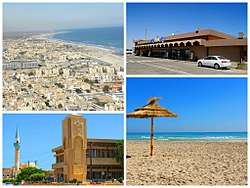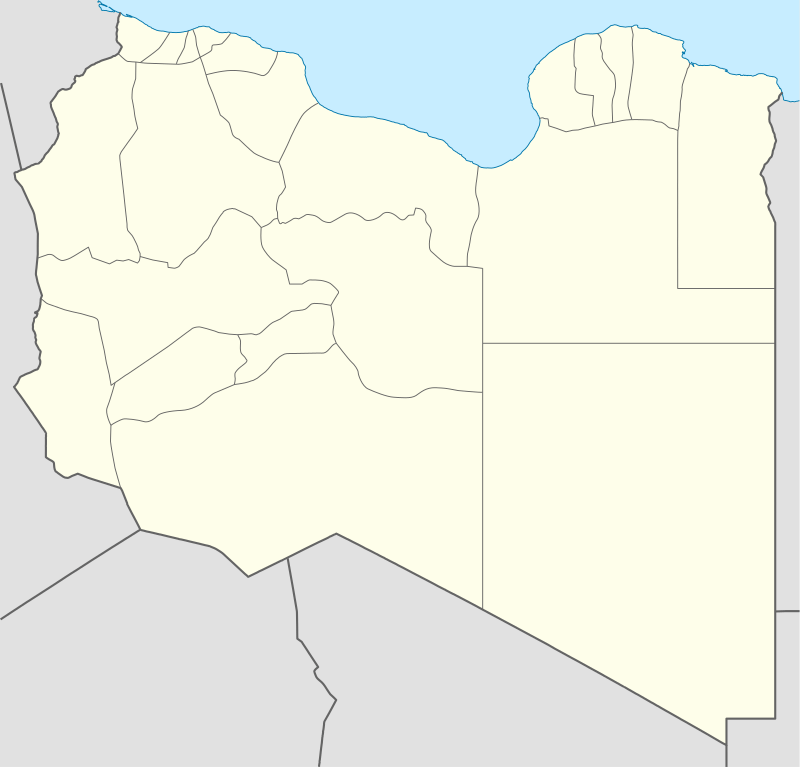Zuwarah
| Zuwara زوارة ⵜⴰⵎⵓⵔⵜ ⵏ ⵡⴰⵜ ⵡⵉⵍⵍⵓⵍ | ||
|---|---|---|
| City | ||
 | ||
| ||
 Zuwara Location in Libya | ||
| Coordinates: 32°56′N 12°05′E / 32.933°N 12.083°ECoordinates: 32°56′N 12°05′E / 32.933°N 12.083°E | ||
| Country |
| |
| Region | Tripolitania | |
| Elevation[1] | 0 ft (0 m) | |
| Time zone | UTC+2 (EET) | |
Zuwarah, or Zuwara or Zwara (/zʊˈwɑːrə/) (Arabic: زوارة; Berber languages: ⵜⴰⵎⵓⵔⵜ ⵏ ⵡⴰⵜ ⵡⵉⵍⵍⵓⵍ Tamurt n Wat Willul[2]), is a port city in northwestern Libya, with a population of around 350,000 (2013)[3], famous for its beaches and seafood. It is situated 102 km (63 mi) west of Tripoli and 60 km (37 mi) from the Tunisian border. It is the capital of the Nuqat al Khams district. Its population speaks Zuwara Berber, a Zenati Berber language.
History
The settlement was first mentioned by the traveller al-Tidjani in the years 1306-1309 as Zwara al-saghirah ("Little Zwarah").[4] In a Catalan sailing manual (1375) it was called as Punta dar Zoyara. The town is mentioned by Leo Africanus in the 16th century. It later served as the western outpost of Italian Libya (1912–43), being the terminus of the now-defunct Italian Libya Railway from Tripoli 105 kilometres (65 mi) to the east. Its artificial harbour shelters a motorized fishing fleet. Cereals, dates, and esparto grass (used to make cordage, shoes, and paper) are local products.
Climate
| Climate data for Zuwarah | |||||||||||||
|---|---|---|---|---|---|---|---|---|---|---|---|---|---|
| Month | Jan | Feb | Mar | Apr | May | Jun | Jul | Aug | Sep | Oct | Nov | Dec | Year |
| Average high °C (°F) | 17.0 (62.6) |
18.5 (65.3) |
20.3 (68.5) |
22.4 (72.3) |
25.1 (77.2) |
27.8 (82) |
30.2 (86.4) |
31.5 (88.7) |
29.2 (84.6) |
26.3 (79.3) |
23.2 (73.8) |
18.1 (64.6) |
24.1 (75.4) |
| Average low °C (°F) | 7 8 | 10.2 (50.4) |
13.6 (56.5) |
16.3 (61.3) |
19.5 (67.1) |
20.8 (69.4) |
22.4 (72.3) |
21.0 (69.8) |
21.0 (69.8) |
17.1 (62.8) |
12.1 (53.8) |
7.3 (45.1) |
— |
| Average precipitation mm (inches) | 32 (1.26) |
20 (0.79) |
16 (0.63) |
13 (0.51) |
5 (0.2) |
1 (0.04) |
0 (0) |
0 (0) |
10 (0.39) |
29 (1.14) |
32 (1.26) |
44 (1.73) |
202 (7.95) |
| Source: Climate-data.org | |||||||||||||
Cultural revolution
In 1973, it was here in Zuwara that Muammar Gaddafi first proclaimed the Libyan "Cultural Revolution".
2011 Libyan Civil War
In the 2011 Libyan Civil War battles, the city was reported by Al Jazeera to be under control of the local anti-Gaddafi forces on 23 February 2011, and lost by the government of Muammar Gaddafi.[5] Thousands of anti-government protesters, gathered in the Zuwara town square on 24 February, repulsed another Libyan Army attempt to retake the city. Loyalist forces used the pro-government towns of Jumayl and Riqdalin to the south as bases for their attacks on the city.[6] However, from March onwards, the city was under the control of loyalist forces.[7] Amidst the August rebel coastal offensive, rebels took Zuwara on 18 August.[8]
In September 2011, and following the fall of the Gaddafi government, Zuwara was the first town in Libya to democratically elect its local council.[9]
See also
References
- ↑ Wolfram Alpha
- ↑ Mitchell (2007: 29, 195).
- ↑ SIMPSON, M. K. B. The Cemetery Without Graves. Lulu.com. p. 105. ISBN 9781304226860.
- ↑ "Voyage du Scheikh Et-Tidjani dans la régence de Tunis pendant les années 706, 707 et 708 de l'hégire (1306-1309)", transl. by M. A. Rousseau, Journal Asiatique 1853, p. 121.
- ↑ "Live Blog - Libya Feb 24". Al Jazeera English. 23 February 2011. Archived from the original on February 25, 2011. Retrieved 24 February 2011.
- ↑ Draper, Robert (February 2013). "New Old Libya". National Geographic. p. 46.
- ↑ NPR; "Militias In Libya Attack Protesters" Archived May 29, 2016, at the Wayback Machine.; February 24, 2011; Accessed 2001-02-24.
- ↑ "Rebels claim control of Libya's last functioning oil refinery". The Washington Post. 18 August 2011. Retrieved 18 August 2011.
- ↑ "The voice of Libya's minorities" Archived May 26, 2014, at the Wayback Machine.; November, 2011
Sources
- Terence Frederick Mitchell, Ferhat. An Everyday Story of Berber Folk in and around Zuara (Libya), Köln, Köppe, 2007 - ISBN 978-3-89645-396-9
External links
- Official Zuwara Municipality website - in Tamazight and Arabic
- official Zuwara website - in Arabic
